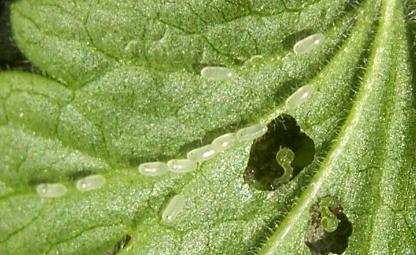Gooseberry Sawfly Larva
Scientific Name: Nematus ribesii
As the name suggests these little pests attack the leaves of goosebery bushes; also
red and white currants, but not black currants - maybe the strong aroma of the leaves puts them off.
The adult female lays its eggs on the underside of the leaves at the centre of the bush close to the ground. When they
hatch the first instar of the larval stage is very small and makes tiny holes in the leaf. The
next stages are much bigger, up to 20mm long, and they cause the most damage, stripping the bush bare as they move outwards along the branches.
The early instars make small holes in the leaves. Picking off any leaves like this should clear up the infestation.
The lack of foliage weakens the bush and it produces a very poor crop the following year.
All of the inner leaves on this bush have been completely eaten away and only the outermost remain.
There can be up to three generations in a season, so the damage can occur anytime between May and September. The best control is to examine the bushes carefully in late April, looking for the eggs or the early larval stage low down in the centre of the bush.

The white eggs are attached to the veins. Also some of the first instar larvae are showing the characteristic S-shape.
When the early signs are spotted remove the affected leaves to ensure all of the eggs and larvae are cleared.
A spray of derris, particularly to the undersides of the leaves when the small larvae are found, and repeated after two weeks, should clear up one generaton. The Elder shoot preparation described on the Recipes page can be sprinkled or sprayed onto the pests. There is no biological control, apart from chickens, that is.
Back to GARDEN CREATURES